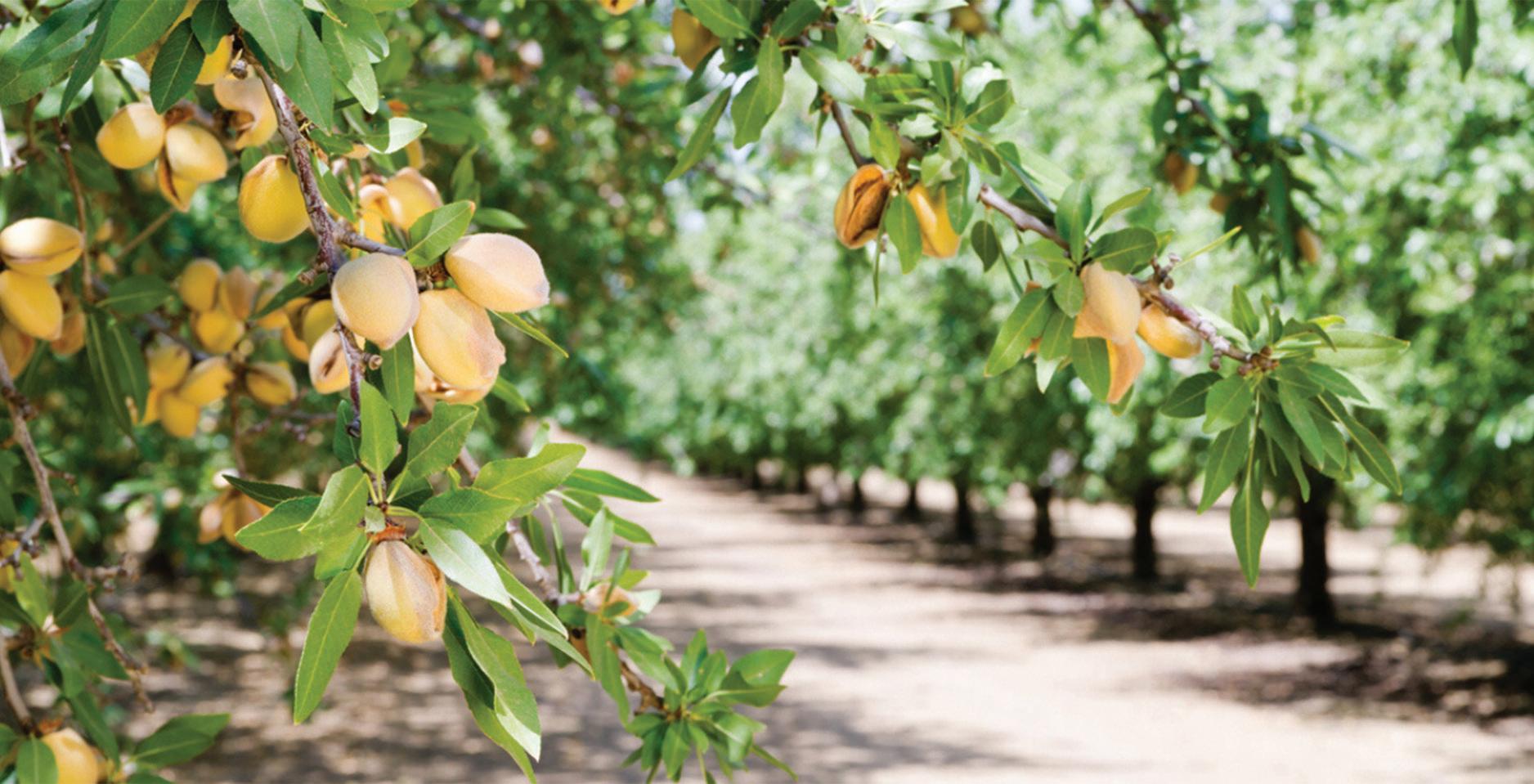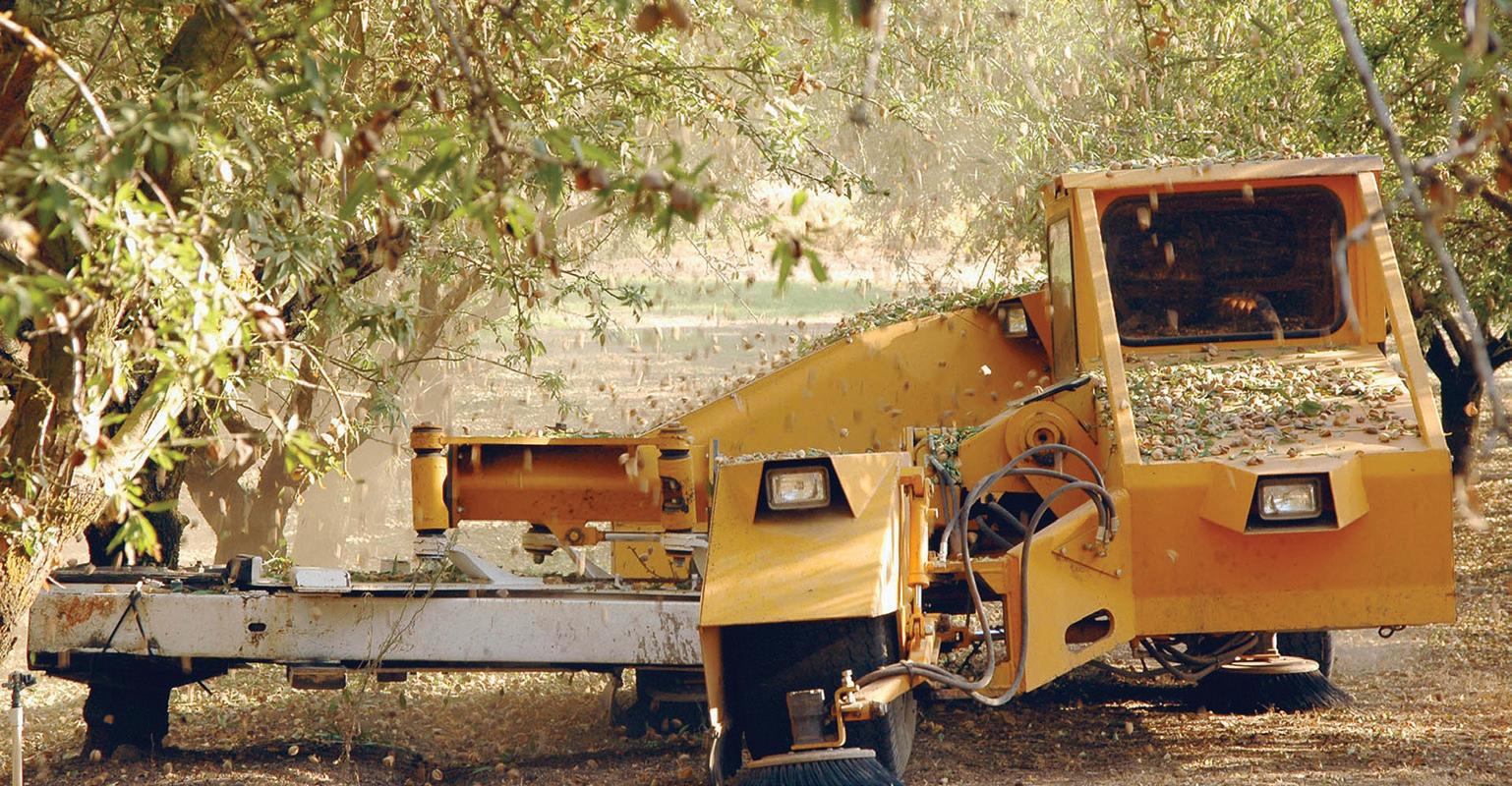
6 minute read
WALNUT FORECAST
STAFF REPORTS
The 2020 California walnut production is forecast at a record 780,000 tons, up 19 percent from 2019's production of 653,000 tons. The forecast is based on 380,000 bearing acres, up 4 percent from 2019’s estimated bearing acreage of 365,000.
A warm and dry January and February meant growers started irrigating early. The 2020 chilling hours were low. Leaf-out was prolonged, which resulted in uneven canopy and nut development. April rains increased blight risk. Nut sets looked good, with reports of tree limbs heavy with nuts. Harvest is expected to begin in early September, ahead of last year.
Survey data indicated an average nut set per tree of 1,197, up 22 percent from 2019’s average of 983. Percent of sound kernels in-shell was 98.5 percent statewide. In-shell weight per nut was 22.0 grams, while the average in-shell suture measurement was 32.2 millimeters. The inshell cross-width measurement was 33.2 and the average length in-shell was 38.6 millimeters. All of the sizing measurements were either the same or below the previous year’s levels.
The Walnut O.M. Survey began in 1958 to fulfill industry needs for an accurate walnut production forecast prior to harvest. The original sample was chosen proportionally to county and variety of bearing acreage. With each succeeding year, additions and deletions have been made in the sample to adjust for acreage removed, new bearing acreage, and operations that choose not to participate in the survey.
The 2020 Walnut Objective Measurement (O.M.) Survey was officially conducted from Aug. 1 through Aug. 20, 2020. There were a few samples completed before Aug. 1 for training and scheduling purposes. There were 1,450 trees sampled from 725 orchards.
Once a block is randomly selected and permission is granted by the operation for enumerators to enter the block, two trees are randomly selected. An accessible branch is chosen which is 5- 15 percent of the total cross-sectional area of the primary limbs and reachable with a twelve-foot ladder. Measurements are made on the trunk, each primary, and each split leading to
and including the accessible branch. The sample tree and accessible branch are marked by a single tag, so that the same trees are sampled the following year if that orchard is selected. On the accessible branch, every nut is counted and the first of every five nuts is picked for use in size and grade determinations. If available, at least ten nuts are harvested from the accessible branch for this purpose.
HERE FOR YOU WHEN YOU NEED US MOST!





PROTECTING CALIFORNIA’S AG INDUSTRY ✓ Farm & Ranch Insurance Packages ✓ Age Processing & Manufacturing ✓ Custom Farming Operations ✓ Workers' Comp | Health Benefits turlockinsurance.com • (209) 250-0269
Additional assistance to farmers and ranchers impacted by coronavirus
STAFF REPORTS
The USDA announced up to an additional $14 billion dollars for agricultural producers who continue to face market disruptions and associated costs because of COVID-19. Signup for the Coronavirus Food Assistance Program (CFAP 2) is underway and will continue through Dec. 11, 2020.
The USDA will use funds being made available from the Commodity Credit Corporation (CCC) Charter Act and CARES Act to support row crops, livestock, specialty crops, dairy, aquaculture and many additional commodities. USDA has incorporated improvements in CFAP 2 based from stakeholder engagement and public feedback to better meet the needs of impacted farmers and ranchers.
Producers can apply for CFAP 2 at USDA’s Farm Service Agency (FSA) county offices. This program provides financial assistance that gives producers the ability to absorb increased marketing costs associated with the COVID-19 pandemic. Producers will be compensated for ongoing market disruptions and assisted with the associated marketing costs.
CFAP 2 payments will be made for three categories of commodities – Price Trigger Commodities, Flat-rate Crops and Sales Commodities.
Price trigger commodities are major commodities that meet a minimum 5-percent price decline over a specified period of time. Eligible price trigger crops include barley, corn, sorghum, soybeans, sunflowers, upland cotton, and all classes of wheat. Payments will be based on 2020 planted acres of the crop, excluding prevented planting and experimental acres.
For broilers and eggs, payments will be based on 75 percent of the producers’ 2019 production.
Dairy (cow’s milk) payments will be based on actual milk production from April 1 to Aug. 31, 2020. The milk production for Sept. 1, 2020, to Dec. 31, 2020, will be estimated by FSA.
Eligible beef cattle, hogs and pigs, and lambs and sheep payments will be based on the maximum owned inventory of eligible livestock, excluding breeding stock, on a date selected by the producer, between Apr. 16, 2020, and Aug. 31, 2020.
Crops that either do not meet the 5-percent price decline trigger or do not have data available to calculate a price change will have payments calculated based on eligible 2020 acres multiplied by $15 per acre. These crops include alfalfa, extra long staple (ELS) cotton, oats, peanuts, rice, hemp, millet, mustard, safflower, sesame, triticale, rapeseed, and several others.
Sales commodities include specialty crops; aquaculture; nursery crops and floriculture; other commodities not included in the price trigger and flat-rate categories, including tobacco; goat milk; mink (including pelts); mohair; wool; and other livestock (excluding breeding stock) not included under the price trigger category that were grown for food, fiber, fur, or feathers. Payment calculations will use a sales-based approach, where producers are paid based on five payment gradations associated with their 2019 sales.
Additional commodities are eligible in CFAP 2 that weren’t eligible in the first iteration of the program.
Time for a Change? Time for a Change?
What’s a media room?

Maybe we should convert Jeb’s old bedroom to a media room.
We’ve all been spending a lot more time at home lately — which makes this a great time to think about how we can make that experience even better. If you’re looking to make a change we can help with financing for home improvements, repairs or even a new home. Talk to one of our lending professionals today. Apply and get approved online or call one of our friendly loan officers at 1-844-700-5012 — we’ll make the process as simple as possible.
LOCALLY OWNED, FAMILY OPERATED OVER 30 YEARS OF EXPERIENCE!

Residential Commercial & Industrial Plumbing Services! CALL NOW 209-581-0480



Our Services Include: Sinks / Drains / Faucets • Septic Tanks and Sewer Lines Grease Traps / Floor Drains • Toilets / Water Heaters / Backfl ow Prevention • Hydro-Jetting / Preventative Maintenance Inspection • Gas and Water Pipelines Repair / Remodeling / Re-Piping Storm Water Treatment / Lift Station Maintenance SWTD Filter Replacements and MORE!
24 HOUR EMERGENCY SERVICE AVAILABLE!
4425 Farm Supply Drive, Ceres CA, 95307 ateeplesdrilling@sbcglobal.net www.applegateteeplesdrilling.com








